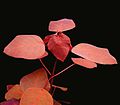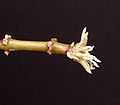Euphorbia cotinifolia
| Euphorbia cotinifolia | ||||||||||||
|---|---|---|---|---|---|---|---|---|---|---|---|---|

Euphorbia cotinifolia subsp. cotinifolia |
||||||||||||
| Systematics | ||||||||||||
|
||||||||||||
| Scientific name | ||||||||||||
| Euphorbia cotinifolia | ||||||||||||
| L. |
Euphorbia cotinifolia is a species in the genus spurge ( Euphorbia ) from the family of Euphorbiaceae (Euphorbiaceae). The botanical name refers to the similarity of the foliage with that of the wig bush ( Cotinus coggygria )
Description and origin
Euphorbia cotinifolia forms a somewhat succulent shrub or tree from 2 to 6 (occasionally up to 19) m in height and with a round crown . Their trunks are often thickened in the shape of a bottle at the base and covered by a white bark when they are old . The cylindrical, initially about 6 mm thick branches are articulated and branch into three whorls at the nodes . The leaves also appear in three-whorls at the nodes. These are rounded, triangular to broadly oval, about 4 to 14 cm long, 2 to 7 cm wide and pure green. They sit on stems that are about as long as the leaves.
The inflorescences are terminally and laterally formed. Multiple forked branches, especially on the side branches of the inflorescence, create a flat inflorescence head. The cyathia are 2 to 4 mm in size. Their four to six nectar glands are oval to almost circular, greenish and have about 1 mm long, white to cream-colored petal- like appendages.
Subspecies and their occurrence
- Euphorbia cotinifolia subsp. cotinifolia is the green-leaved subspecies described above that is not in culture. It grows wild in Central to South America, from Mexico to the Caribbean islands and Venezuela to Brazil at altitudes of 200 to 2600 m above sea level. According to R. Govaerts, however, this subspecies only occurs in the Netherlands Antilles.
- Euphorbia cotinifolia subsp. cotinoides ( Miq. ) Christenh. is the subspecies in culture. It differs through striking red-brown foliage, initially red-brown twigs and denser inflorescences. In nature it occurs in the Amazon region of Suriname at altitudes between 0 and 500 m above sea level, but is kept as an ornamental plant in tropical and subtropical areas around the world and is partly overgrown there. According to R. Govaerts, this subspecies originally occurs from Mexico and Trinidad to Peru.
cultivation
With its brightly colored foliage, Euphorbia cotinifolia subsp. cotinoides a very decorative ornamental plant that can be successfully kept as a container plant in Germany . A year-round cultivation in a greenhouse is possible, but the plants then usually become long and do not branch much. They become more beautiful and stocky when they can spend the summer outdoors. The prerequisites for a successful cultivation are nutritious but well-drained soil and a warm and very bright place. Waterlogging and temperatures below about 10 ° C are not tolerated. A lot of direct sun is not necessary and is often not well tolerated. Especially in spring, when the plants are no longer used to the sun, make sure that the leaves do not get burned.
Since all the leaves are shed in autumn, the plants are bare in winter. They now need a rest period in which they must be kept warm (around 15 ° C) and dry. If watering over the winter, the plants may sprout and then rot due to lack of light or they rot from the roots. Since the outer branches dry back in winter anyway, now is the best time to cut the plants into shape. Pay attention to the special toxicity of the milk juice !
Propagation is possible in spring and summer by cutting cuttings . A safe method is to select twigs that are already slightly woody and not too fresh, to put them in a glass of water after the cut, to wait until the roots are 2 to 3 cm long and then to pot the young plants.
gallery
Euphorbia cotinifolia subsp. cotinoides
literature
- C. Linnaeus: Species Plantarum (ed.1) 1: 453, 1753
- Friedrich Anton Wilhelm Miquel: Linnaea 21: 473, 1884, online
- Maarten Christenhusz: Harvard Pap.Bot . 7 (1): 3, 2002
- Volker Buddensiek: Succulent Euphorbia plus , 2005, CD-ROM, ISBN 3-934396-03-8
Individual evidence
- ^ A b Rafaël Govaerts (Ed.): Euphorbia - World Checklist of Selected Plant Families of the Royal Botanic Gardens, Kew. Last accessed on May 20, 2017.



